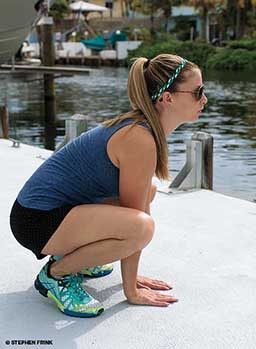Developed in Japan almost two decades ago and designed for training athletes, early versions of the Tabata protocol were tested on Japanese speed skaters who, despite training for a mere two hours per week, showed significantly greater improvements in both aerobic and muscular fitness than did the control group, which trained for five hours a week. Despite the dramatic success of this training method, Tabata has only recently become popular in mainstream fitness.
True Tabata training involves 20 seconds of maximum-intensity activity followed by 10 seconds of rest for eight rounds, resulting in four minutes of high-intensity exercise. Because this program was originally designed for extremely fit athletes, the original protocol is enough to cause nausea in many people. Fortunately, people of most fitness levels can benefit from lower-intensity variations of training that applies the principles of Tabata.

A worldwide survey by the American College of Sports Medicine identified high-intensity interval training (HIIT) as the No. 1 fitness trend for 2014. When practitioners engage in HIIT responsibly, the technique provides optimal health benefits in a relatively short period, making it a popular workout. For the purposes of HIIT, “intensity” is a relative term based on your personal fitness level. Intensity is simply a percentage of your maximum effort.
Although the original protocol was designed using a cycle ergometer (stationary bike), any large-muscle-group exercises can be used for Tabata training. When you practice Tabata training, you can use the exercises provided here or substitute exercises from previous issues of Alert Diver. When selecting exercises, consider that transition time from one exercise to the next is included in the rest interval, so some practitioners use the same exercise for all eight rounds. The key elements of this type of training are time and intensity.
Before you jump in, begin with a 10-minute, movement-specific warm-up. Complete five repetitions of each exercise, gradually increasing the speed and range of motion. Then set your timer. You can use a traditional stopwatch, wall clock, Tabata trainer or one of many apps available.
For rounds five through eight, repeat the exercises and intervals you used in the first four rounds. You may be able to complete only four rounds at first. That is perfectly acceptable as long as you work toward completion of eight rounds of maximal yet safe effort. Pushing through some discomfort due to tired muscles is good; pushing through pain can lead to injury. Listen to your body. The goal is to complete each repetition as fast possible without compromising your technique.
Your Tabata training should always be followed by a three- to 10-minute cooldown. Make sure to stretch all areas that feel fatigued.
Burpee (No Push-Up)

- Begin standing.
- Squat until your hands touch the ground.
- Jump your feet back intso push-up position.
- Jump your feet forward again.
- Stand up.
- Repeat.
Tip: Maintain a tight core to help keep your back straight.
Modification: Replace push-up position with lying prone on the ground.
Inchworm
- Begin standing.
- Bend down, keeping your knees as straight as possible (forward fold).
- Walk your hands forward (left, right, left) until you are in push-up position.
- Walk your hands back (right, left, right) until you are back in forward fold.
- Stand up.
- Repeat.

Tip: The straighter your knees (without being locked), the more you will stretch your calf muscles. Improving calf flexibility can reduce calf cramps during finning.
Modification: Bend your knees to get to the floor. Each session you will be able keep your knees a little straighter.

Speed Skater
- Stand with your feet shoulder width apart.
- Flex (bend) your knees about 45 degrees.
- Flex at the hips so your shoulders are above your knees.
- Hop sideways (to the right), landing on your right foot.
- Hop sideways (to the left), landing on your left foot.
- Repeat.
Tip: Keep your chest up, and start with short jumps; you can increase the distance with each session.
Modification: Shorten your jumps, and allow your other foot to touch the ground for stabilization.
Ski Abs

- Start in plank position (the “up” phase of a push-up).
- Jump both feet toward your left hand.
- Jump both feet back into plank position.
- Jump both feet toward your right hand.
- Jump both feet back into plank position.
- Repeat.
© Alert Diver — Q1 Winter 2015